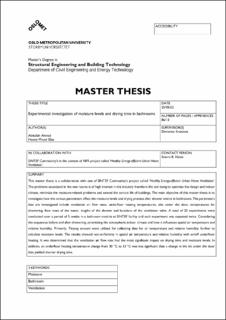| dc.description.abstract | Achieving comfortable indoor relative humidity and air temperature are desirable for any given user. As extreme levels of relative humidity can cause significant damages in buildings. Therefore, it of the utmost importance to navigate the moisture from the bathroom in an effective way thus reducing potential damage to the buildings.
The objective of the project at SINTEF Community that is linked to work package 3, is to find the optimal solutions and recommendations for ventilation strategies for urban residential buildings in Norway. Thus, in this study, certain parameters like ventilation air flow rate, underfloor heating temperature, slit under the door, temperature for showering, flow rate of the water, length of the shower and location of the ventilation valve were investigated. It was investigated how these various parameters will affect the moisture levels and drying time in the bathroom module at SINTEF facility. In addition, considering how spatial distribution of air temperature and relative humidity were affected under various parameters as mentioned.
Hence, a series of experiments were conducted at the SINTEF Community laboratory. A total of 22 experiments were conducted over a period of 5 weeks. Adjustments and modifications were made to the bathroom module by installing ventilation exhaust, underfloor heating, supply of water and drainage system. The choice of selected parameters was based on the literature review. In addition, a preliminary plan was devised to test and lock the parameters to limit the boundaries of the study and emphasises were laid upon parameters including ventilation air flow rate (36 m3/h, 54 m3/h, 72 m3/h, and 108 m3/h), underfloor heating temperature (off, 30 °C and 33 °C) and slit under the door (5 mm, 15 mm, and 30 mm). After conducting the preliminary plan, the length of the shower was locked at 10 minutes at 100% flow rate of shower water, 41 °C shower temperature and the location of the ventilation valve was above the shower area.
The results clearly yielded that the most significant parameter that determines the drying time is the ventilation air flow rate. Subsequently, combination of high ventilation air flow rate with slit under the door and underfloor heating turned on gives the most optimal results in this study. Concluding that the most effective way to control the moisture levels in the bathrooms is by increasing the ventilation air flow rate followed by underfloor heating turned on as this helps with rapid evaporation of water on the floor. However, when comparing an increase in underfloor heating from 30 °C to 33 °C is less significant than an increase in the slit under the door. | en_US |
